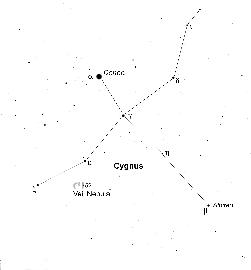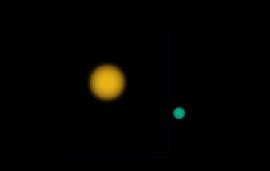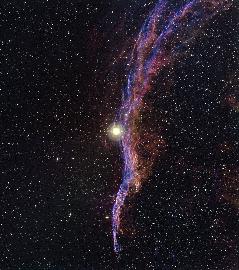Cygnus
Cygnus lies along the plane of the Milky Way and its brightest stars can get lost against the magnificent backdrop of stars if the sky is too dark and clear! These stars form what is called the Northern Cross. Cygnus contains over 11 open clusters but none have made the A-List. Just two objects have: a beautiful double star system - perhaps the very best in the sky - and the faint nebulosity of a fading supernova explosion. Cygnus is best observed during the months from August to December.
Albireo Double Star E H
This is perhaps the most beautiful double star in the sky with a wonderful colour contrast between the brighter component, magnitude 3 and yellow-gold or amber in colour and its fainter, 5.1 magnitude, companion which is a vivid blue-green in colour. As they are separated by 34 arc seconds, any telescope will split them even under the worst of seeing conditions. If 10x 50 binoculars are held very steadily or mounted on a tripod they should also be able to show that Alberio is a double. (This is where image stabilised binoculars would be very useful!) They are 380 light years away and the primary component is a K-type star that has evolved off the main sequence whist its fainter companion is a, hotter but smaller type B main sequence star. This pair gives us an immediately observable proof that stars evolve. As the two stars lie at the same distance we know that the yellow-gold star we know is six times more luminous than the blue star.&mnsp Whilst stars lie on the main sequence, they are burning Hydrogen into Helium in their cores. The more massive stars are brighter and hotter, emitting blue or white light, whilst the less massive ones are less bright and emit yellow, orange or red light. A main sequence yellow star would thus be far less bright than a blue star. So the yellow star in Alberio cannot be a main sequence star. In fact, it has evolved away from the main sequence during the following phase of its life and has become a yellow giant as it converts helium into heavier elements. It has become far bigger in size and, although each square meter of the surface emits less light than that of the blue star, its surface area is so much larger that overall it emits 6 times more light.
Position: 19h 30.7m +27deg 57min
Veil Nebula Supernova Remnant B L
This is one of the most challenging of all the A-List objects to observe as it requires very dark and transparent skies to make out the faint nebulosity against the sky background. However as indicated at the end the use of an appropriate filter can make it visible under less good conditions. If you can find an observing site with little or no light pollution and the skies are transparent - perhaps when heavy rain has washed the dust out of the atmosphere - then parts of the veil nebula can be seen even with 8 x 40 binoculars. The veil nebula is the wispy nebulous remnant of a star that exploded some 5,000 years ago in what is called a Type II supernova. For a brief period its brightness could have rivalled that of the Moon and it would have been visible in broad daylight. There remain three main areas of nebulosity in a roughly circular outline: NGC 6992 and 6995, making up Caldwell 33, to the east with NGC6960, C34, to the west. C34, though somewhat less bright than C33, is easier to find as it runs north-south "through" the 4.2 magnitude star 52 Cygni. This star is 3 degree south of Epsilon Cygni, the eastern star of the Northern Cross. So centre this in your binoculars or finder and drop south by less than one field width to find 52 Cygni and, hopefully, the faint hints of nebulosity. The slightly brighter parts of the nebulosity that make up C33 are 2.5 degrees to the east and very slightly north so the whole of the veil can be easily encompassed using 8 x 40 or 10 x 50 binoculars. Using a telescope, only a 2 inch, wide-field, eyepiece and a short focal length could encompass the whole field. In any event, use your lowest power eyepiece. Find Epsilon Cygni first, lock the RA axis and drop down in dec by 3 degrees to centre 52 Cygni in the field and try to observe the nebulosity there ( this is C34), then, with the declination axis locked, sweep eastwards by 2.5 degrees. Lock the right ascension axis and inch up perhaps half a degree in declination to observe the nebulosity of C33. At same declination as C33 moving two thirds of the way back towards C34 you may glimpse a third area of nebulosity running north-south through a slightly inclined chain of stars. One way to increase your chance of observing it is to use a Ultra High Contrast (UHC) or "O III" filter. These cost ~ ?50 and cut out much of the light pollution BUT allow the light from the nebulosity to pass through - making it far easier to see. Good hunting!
Positions:
C33 20h 56.4m +31deg 43min
C34 20h 45.7m +30deg 43min






